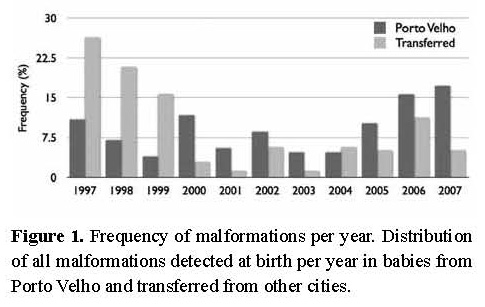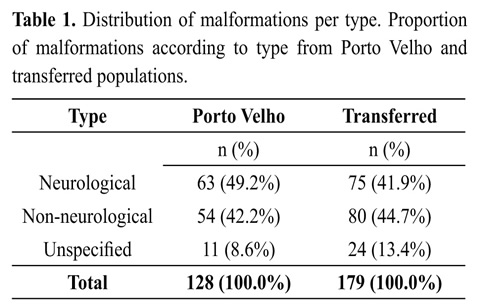Services on Demand
Journal
Article
Indicators
-
 Cited by SciELO
Cited by SciELO -
 Access statistics
Access statistics
Related links
-
 Cited by Google
Cited by Google -
 Similars in
SciELO
Similars in
SciELO -
 Similars in Google
Similars in Google
Share
Revista de la Universidad Industrial de Santander. Salud
Print version ISSN 0121-0807On-line version ISSN 2145-8464
Rev. Univ. Ind. Santander. Salud vol.43 no.3 Bucaramanga Oct./Dec. 2011
Mercury pollution and congenital
malformations detected at birth in
Porto Velho, Brazil, from 1997 to 2007
Julio Cesar da Rocha1, Rafael S. Maior2, Carlos Tomaz2*
1. Health Sciences Graduate Program, Faculty of Health Sciences, University of Brasília, CEP 70910-900, Brasilia, DF, Brazil.
2. Laboratory of Neuroscience and Behavior, Department of Physiological Sciences, Institute of Biology, University of Brasilia,
CEP 70910-900, Brasilia, DF, Brazil
Correspondencia: Carlos Tomaz. Laboratory of Neurosciences and Behavior, Department of Physiological Sciences,
Institute of Biology, University of Brasília, CEP 70910-900, Brasilia, DF, Brazil. Phone: +55 61 3107 2919. Fax: +55 61 3107 2926.
E-mail: ctomaz@unb.br.
Recibido: 2 de Octubre de 2011 Aceptado: 30 de Octubre de 2011
ABSTRACT
The possible negative impacts of mercury contamination in the Madeira river, State of Rondonia, Brazil, on newborn babies health were evaluated. The incidence of congenital malformations was surveyed from the records of newborns in the main hospital of Porto Velho, Rondonia, from 1997 to 2007. The type of malformations between local population and cases transferred from other areas in Rondonia were compared. Neurological related malformations were found in 45% of the cases. The proportion of neurological defects in the local population was slightly higher than in transferred cases. Non-neurological malformations represented 43% of the sample and, 11.4% were unspecified. The incidence of general (including non-neurological) congenital malformations was similar to the region's average. This is indicative of Hg contamination during pregnancy. Salud UIS 2011; 43 (3): 237-240
Keywords: Newborn, congenital malformation, environmental factor, mercury
Contaminación por mercurio y las malformaciones
congénitas detectadas en el nacimiento en
Porto Velho, Brasil, entre 1997 y 2007
RESUMEN
Los posibles impactos negativos de la contaminación por mercurio en el río Madeira, Estado de Rondonia, Brasil, en la salud de los bebés recién nacidos fueron evaluados. La incidencia de malformaciones congénitas fue examinado en los registros de los recién nacidos en el principal hospital de Porto Velho, Rondonia, de 1997 a 2007. El tipo de malformaciones entre la población local y los casos transferidos de otras zonas de Rondonia fueron comparados. Malformaciones neurológicas relacionadas se encontraron en el 45% de los casos. La proporción de defectos neurológicos en la población local fue levemente superior en los casos transferidos. Malformaciones non neurológicas representó el 43% de la muestra y, el 11,4% sin especificar. La incidencia de la general (incluyendo non neurológicas) malformaciones congénitas fue similar al promedio de la región. Esto es indicativo de contaminación de mercurio durante el embarazo. Salud UIS 2011; 43 (3): 237-240
Palabras Clave: Malformación del recién nacido, congénitas, factor ambiental, el mercurio
INTRODUCTION
Mercury (Hg) contamination of riparian populations along the banks of Madeira river is serious health issue. It is estimated that during the gold rush of the 1980's around 3000 tons of Hg has been released into the river1. Current high levels of human and fish Hg concentration seem to be similar to those during the peak of goldmining activities2. The concentration is also high for sediments, soil and water along the Madeira river3. This means that riparian populations are still subject to constant exposure to increased available Hg in the environment.
Fish consumption is thought to be the principal route for Hg contamination in humans. Indeed, most species of fish sampled from Madeira river present aboverecommended levels of Hg and riparians tend to rely heavily on fish consumption for survival4. These populations were shown to be even more subject to Hg contamination than gold miners up the river5.
Hg contamination may cause congenital defects but, apart from dramatic events such as the Minamata poisoning episode6, this is generally difficult to show in epidemiological studies. Nevertheless, Hg easily crosses the blood-brain barrier and may reach the foetus through the placenta7. Indeed, Oliveira and co-workers4 found a correlation between in maternal and breastfeeding babies hair Hg concentrations. Contamination during pregnancy may lead to congenital malformation in babies, neurological and otherwise8. Therefore, the aim of the present study was to compare the occurrence of congenital malformations between populations living along Madeira river in the State of Rondonia and those from other areas where no gold mining activities have been reported.
METHODS
We analysed all birth medical records, from 1997 to 2007, in the Hospital de Base in Porto Velho, State of Rondonia, Brazil. The medical records indicating congenital malformation (307 of the total) were selected for further analysis. The Hospital de Base of Porto Velho receives patients from the city of Porto Velho, who live along the Madeira riverside, as well as the countryside of the State of Rondonia, where no previous gold mining activity has been reported. Therefore, the medical records were divided according to provenance for comparative purposes. The data found here were compared to the national health indicators where appropriate.
RESULTS
From the 307 medical records analysed, we found 128 (41.7%) with congenital malformations from children of Porto Velho and 179 (58.3%) from children transferred from other cities. Figure 1 shows the distribution of births with malformation according to provenance across the 10-year span considered. A higher prevalence for children transferred from outside Porto Velho was found in 1997 whereas children from Porto Velho with malformations were found more prevalent in 2007.
Table 1 shows the kind of malformation according to provenance. There were a total of 138 (45.0%) cases of neurological malformations, 134 (43.6%) of nonneurological and 35 (11.4%) of unidentified cases. Neurological defects make up the majority of Porto Velho congenital malformations, 63 cases (49.2%). Neurological defects in children transferred from outside Porto Velho accounted for 75 (41.9%) of malformation cases.
The prevalence of congenital malformation in the Hospital de Base for the summed ten-year period analysed was 0.43%. Data from the Ministry of Health, Brazil (DATASUS/SINASC)9 show a similar figure for the State of Rondonia (0.44%). Brazil's south and southeast regions varied in the same period from 0.53% to 0.73% from 2000 to 2007. The information regarding the type of congenital defect however is not available in the national health system.
DISCUSSION
In this preliminary work, we show that the population along the Madeira river presents a slightly higher percentage of neurological malformations as compared to those living elsewhere in the same State. Although the prevalence for general malformation is in keeping with regional and national indicators, the proportion of neurological defects make up the majority of malformations found in the sample analysed. Neurological symptoms are known to appear in babies whose mothers were exposed high levels of Hg during pregnancy8. Although the Hg levels found in the Madeira river fish and water are nowhere near the Minamata poisoning tragedy, they are still alarmingly high3,10,2. The population dietary intake of fish is also above recommended levels, which in turn further aggravates the problem of Hg contamination4.
Surprisingly, the proportion of congenital defects (neurological or otherwise) in the first three years included (1997-99) was higher for non-residents of Porto Velho. This trend was reversed from 2000 onwards but the lack of information in medical records precludes a clear explanation for the initial difference. Due to poor medical recording practices in the present hospital, especially in the early years, and the dearth of follow-up exams, we were unable to analyse each case in more detail. It also explains the relative high frequency of unspecified cases shown in Table 1. The impact of Madeira river Hg on new generations is still hard to measure.
Regardless, mandatory testing of blood or hair samples for mercury contamination in case of congenital malformation birth or ideally in any birth the region would allow greater insight in the impact of Hg contamination of Madeira river on foetus and neonate neural development. Future work should focus on such initiatives to establish a direct causal relation regarding neurological malformation on these populations. Although overall incidence of malformation is within national averages, high levels of Hg may be skewing the proportion of neurological defects.
CONCLUSION
Despite methodological limitations, the present study indicates that Hg poisoning may be increasing the prevalence of neurological malformations in populations living near the Madeira river. These preliminary data warrants further investigations into this serious public health issue.
CONFLICT OF INTEREST
The authors declare that no competing interests exist.
ACKNOWLEDGEMENTS
R.S. Maior was recipient of a doctoral fellowship from National Council for Scientific and Technological Development-CNPq/Brazil.
REFERENCES
1. Lacerda LD. Updating global mercury emissions from small-scale gold mining and assessing its environmental impacts. Environ Geol 2003; 43: 308-314. [ Links ]
2. Bastos WR, Almeida R, Dórea JG, Barbosa AC. Annual flooding and fish-mercury bioaccumulation in the environmentally impacted Rio Madeira (Amazon). Ecotoxicol 2007; 16: 341-346. [ Links ]
3. Lechler PJ, Miller JR, Lacerdac LD, Vinsond D, Bonzongoe JC, Lyonsd WB, et al. Elevated mercury concentrations in soils, sediments, water, and fish of the Madeira River basin, Brazilian Amazon: a function of natural enrichments? Sci Total Environ 2000; 260: 87-96. [ Links ]
4. Oliveira RC, Dórea JG, Bernardi JVE, Bastos WR, Almeida R, Manzatto AG. Fish consumption by traditional subsistence villagers of the Rio Madeira (Amazon): Impact on hair mercury. Annals Human Biol 2010; 37: 629-642. [ Links ]
5. Maurice-Bourgoin L, Quirogab I, Chincherosc J, Couraud P. Mercury distribution in waters and fishes of the upper Madeira rivers and mercury exposure in riparian Amazonian populations. Sci Total Environ 2000; 260: 73-86. [ Links ]
6. Harada M. Minamata disease: methylmercury poisoning in Japan caused by environmental pollution. Critical Rev Toxicol 1995; 25: 1-24. [ Links ]
7. Kerper LE, Ballatori N, Clarkson TW. Methylmercury transport across the blood-brain barrier by an amino acid carrier. Regu Physiol 1992; 262: R761-R765. [ Links ]
8. Rice DC. Delayed neurotoxicity in monkeys exposed developmentally to methylmercury. Neurotoxicol 1989; 10: 645-650. [ Links ]
9. DATASUS/SINAC [Internet]. Ministry of Health, Brazil. Available from: http://www.datasus.gov.br/ catalogo/sinasc.htm [ Links ]
10. Bastos WR, Gomes JPO, Oliveira RC, Almeida R, Nascimento EL, Bernardi JVE, et al. Mercury in the environment and riverside population in the Madeira River Basin, Amazon, Brazil. Sci Total Environ 2006; 368: 344-351. [ Links ]
















